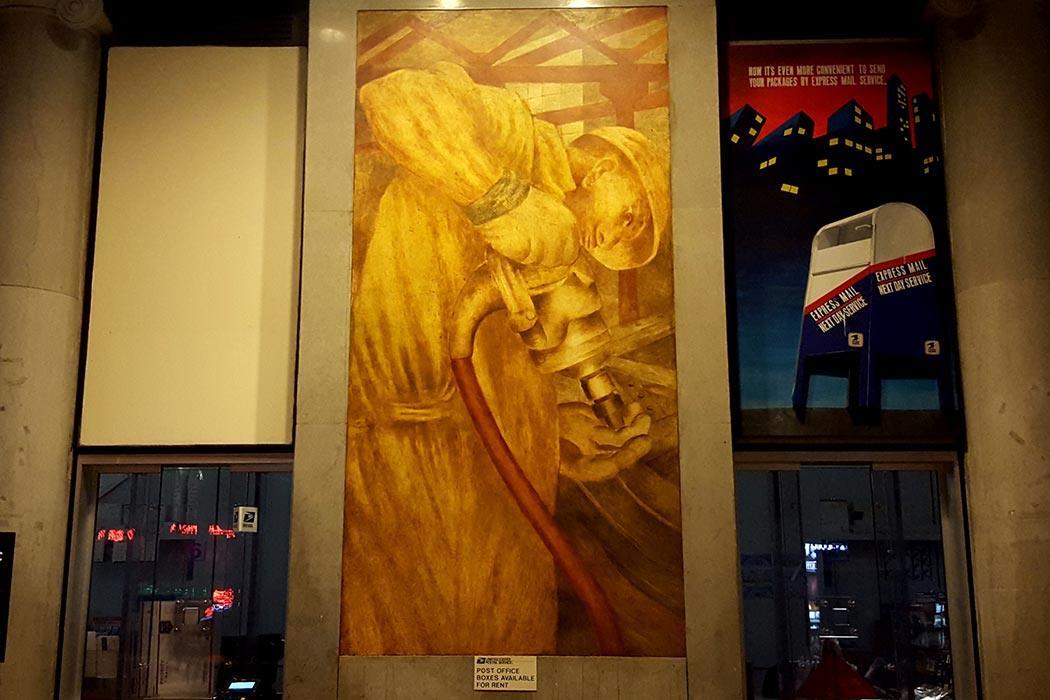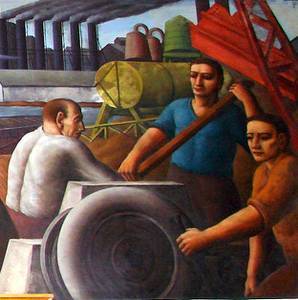The Bronx General Post Office lies across Grand Concourse from a row of fast-food franchises and chain stores. Set back from the busy street by a deep stone patio, its wide stairway flanked by flagpoles, the austere gray brick building takes up the full length of the block. This solid structure seems to embody the promises of the postal service’s unofficial slogan, which adorns New York City’s James A. Farley Post Office Building, near Pennsylvania Station: “Neither snow nor rain nor heat nor gloom of night stays these couriers from the swift completion of their appointed rounds.” It is the building’s interior, however, where this narrative of fortitude and constancy unfolds, in a suite of colorful images both monumental in scale and human in affect.
In 1938, as part of President Franklin Roosevelt’s New Deal, artists Ben Shahn and Bernarda Bryson began work on the 13 colorful, egg-tempera-on-plaster murals commissioned by the Treasury Department’s Section of Painting and Sculpture. Titled “Resources of America,” the Shahn-Bryson murals depict scenes ranging from the harvesting of cotton and wheat to industrial blast furnaces, combining the imagery typically used in regionalist and social realist painting of the 1930s. Self-described humanists, Shahn and Bryson were also lifelong partners and artistic collaborators who shared a belief in the social role of painting. Their murals reflect this. Unlike many depictions of factory work, “Resources of America” does not show human bodies subsumed by machinery, but rather individuals with faces visible, carefully attending to their tasks. Industry is important, but the true subject of each painting is the laborer.The suite of images was inspired by the Walt Whitman poem “I Hear America Singing.” A large central panel on the north end of the lobby depicts two rows of workers, backs turned to us as they read the following Whitman lines on a chalkboard:
For we support all
Fuse All
After the rest is done
and gone we remain
There is no final
reliance but upon us
Democracy rests finally
upon us
(I my brethren begin it)
and our visions sweep
through eternity.
In the brief period from 1933 to 1939, the United States government engaged in what historian William G. Robbins has called “an effort at centralized planning to advance the public good” in the face of the wrenching poverty of the Great Depression. Federally funded public works projects created jobs, built infrastructure (including 1,100 post offices, the Bronx GPO among them), and created one of the largest public art collections in the world. These programs brought about a revival of public interest in mural painting and gave art a central role in the production of the historical record.
Last year, the United States Postal Service sold the Bronx GPO to Youngwoo & Associates, a real estate developer, for $19 million. The murals will remain the property of the USPS, which has entered into a long-term loan agreement with the new owners. The Landmarks Preservation Commission—a municipal preservation agency—recently approved the building’s development as retail space. Nineteen million dollars might seem like a fair deal, and because of the contract with the USPS, the building’s owners are obligated to insure the murals as well as performing routine maintenance. But the transformation of this public property into a privately owned space of consumption is profound. It turns the “we” that remains after “the rest is done and gone” from a collection of workers and citizens into a mass of self-interested consumers.
The Bronx post office is not the only one being sold to a private real estate developer. A film producer bought the post office in Venice, California, in 2012, and the historic post office in Greenwich, Connecticut, has become a Restoration Hardware. Bethesda, Maryland, lost the city’s only landmarked historic building when its Wisconsin Avenue branch—also a New Deal building containing murals—was sold for $4 million. Since 2010, the postal service has sold at least 60 properties and perhaps as many as 100. The 2012 USPS annual report stated that after a review of over 4,000 facilities, more than 600 buildings were “earmarked for disposal.” A significant portion of those sold or listed were historic buildings or eligible for the National Register of Historic Places. This auction of our nation’s history has, however, met significant opposition.
Steve Hutkins teaches travel literature and place studies at New York University. He became interested in the post office sales when, hearing that USPS planned to sell of and close post offices around the nation, he feared his own post office in the town of Rhinecliff, New York, might close. That one-person post office, Hutkins explains, is a crucial part of the tiny community. “You see your neighbors there,” he explains. “It’s a travesty to sell [these buildings] off under the pretense that they are too big or don’t have the cash.”
As Hutkins points out, the sale of post office buildings “is symbolic of the privatization of the postal service as a whole.” He considers these sites, “the crown jewels of what the post offices own.” Even if postal services themselves don’t disappear, much is lost when we move them to anonymous locations in strip malls. Hutkins is emphatic on this point: “Those New Deal post offices are important…there is no pride of place with the new locations.” Even if the mail you receive remains the same, there is an incalculable difference between retrieving it from a historic building and a counter at Staples or Walmart.
It is possible that the buildings themselves will endure. They are, after all, attractive and valuable. In fact, the Shahn-Bryson murals in the Bronx are currently undergoing an intensive process of restoration, paid for by the USPS. According to Peter Schoenmann, a preservationist working for Parma Conservation, the company hired to restore the Bronx murals, the paintings have suffered from layers of coal dust emitted by the original heating system, multiple coats of varnish and some flaking from water damage. The conservators are also removing multiple layers of paint from at least two earlier attempts at restoration that mistakenly matched the coal- and varnish- darkened colors. When all of this is removed, the murals will finally appear as they did upon their completion by Shahn and Bryson.
Schoenmann says there are also plans to restore the original metal grates in the lobby and eliminate some unfortunately garish, postal-themed paintings above the service windows. But even if the lobby ends up looking better after the sale, something will still be lost. The maintenance of these historic murals and buildings will still be subject to the whims of market logic, with public art worth millions of dollars in the hands of a private developer. Hutkins put it this way: “If you think of the post offices as something like a public park, the public owns those parks. It’s akin to selling the parks and turning them into golf courses.”
According to Gray Brechin, a historical geographer at UC Berkeley and founder of the Living New Deal project, this massive sell-off is nothing less than an “assault on the public.” Brechin has taken this assault seriously. He was instrumental in interrupting the sale of Berkeley’s historic post office. After finding out that it had been put on the market, Brechin gave a talk on the issue at the Hillside Club, a community-based organization for the promotion of arts and culture in Berkeley, generating enough buzz to start a significant local movement. City attorney Antonio Rossmann filed a lawsuit in federal district court to stop the sale, as did the National Trust for Historic Preservation, both arguing that the process had violated the National Historic Preservation Act. The court dismissed the suit but placed the sale “under advisement” for the next five years. That means that if the postal service decides that it wants to sell the building, it must alert the community.
As the Berkeley experience shows, the public is not willing to let its treasures go without a fight. Local organizations across the country have been vocal in their opposition to these sales. While a 2013 protest organized by Community-Labor United for Postal Jobs and Services (CLUPJS) at the Bronx GPO, as well as vocal opposition by Borough President Ruben Diaz, Jr., did not block the sale of the building, activities like these have generated enough press to give the USPS pause. Organizations such as the Advisory Council on Historic Preservation and the National Trust have thrown their weight behind the effort to keep these public buildings public, and Congress has taken an interest in slowing the sales. According to Hutkins, this has worked: “For the moment, it appears that the process has slowed down.” A year or two ago, the Postmaster General was talking about closing hundreds of post offices, but this no longer seems to be the case. Only 39 buildings are currently listed on the USPS Properties for Sale website.
The sale of post office buildings is not simply an efficiency, according to Brechin—it is a deliberate erasure of the memory of the New Deal. These murals memorialize a logic that is anathema to the bottom-line thinking that has become a centerpiece of policy-making. Indeed, it is such thinking that underpins the effort to privatize the post office at all, a project that many have shown is not economically necessary for its survival, but a political move to shift money and power into corporate hands. The murals from this period remind us of a time when a different political imagination prevailed: The state was expected to support its citizens, public space was truly public, and an idea such as a 90 percent income tax on the nation’s wealthiest people was considered reasonable.
For defenders of historic post office sites, then, the disappearance of New Deal buildings and artwork from the public sphere is symbolic. In a time of systematic economic and legislative attacks on public infrastructure, we are in danger of forgetting this older, more socially democratic order. Every regime change requires the toppling of monuments, and the sale of New Deal post offices is just that.




















